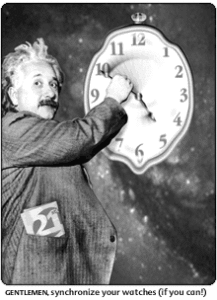I’ve always struggled with time, confined by its parameters that are either too strict or too loose. There is either too much time or not enough. It passes too slowly or it’s as if there never was any to begin with. Every event, milestone, footstep is marked by time. When reading Einstein’s Dreams, so many stories were ideas about time that I had pondered at some point in my life. Especially the story in section 3 where it talks about a world where time stops. I always wondered WHAT IF time stopped, like in Get Smart, would we notice it? If it stopped for minutes or years, would that effect us when it restarted? WHAT IF?
TV & FILM THEMES:
I noticed that a lot of the stories had elements of films I had seen, like the Get Smart related story mentioned above. Whether the book took inspiration from these films and shows, or not these scripts were directly influenced by Einstein’s Dreams is unclear, but I wouldn’t be surprised (tv shows/films after 1992, that is). For example, 20 May 1905: “A world without memory is a world of the present,” is a similar plot to that of 50 First Dates. 2 June 1905 has a similar idea of aging backwards that is reminiscent of Benjamin Button. Most apparent to me was that if I read the book in the voice of Rod Serling, it felt as thought I was reading a season of the Twilight Zone, very sci-fi, yet plausible.
SECTION 4
I read the whole book and focused on section 4. I was confused as to what extent the book was based in reality. Even reading the prologue and back cover, it was unclear whether or not this was a book based on non-fiction, if they were dreams actually had by Einstein adapted by Lightman into this novel, OR wether it was just an idea based on the fact that Einstein was in a particular place doing a particular thing. But maybe half of this was me wanting to believe that these were all stories of real dreams had by Einstein.
Section 4 talks the most about pendulums, as they come up in 2-3 of the stories, enough to notice it as a trend. As the time left in the book winds down, the heaviness of time is felt.
18 June 1905:
This almost seems like a piece of history. People did used to tell time by the sun and how they felt and through natural occurrences – until finally the first clock was created (1656), and time could be tamed and by nature tamed people. Life could now be quantified, people became hyper aware of the sense of time.
22 June 1905:
“…Free in a world without freedom.” In a sense, isn’t that the the US, or life in general? We are free but only to a certain extent. Life has predetermined futures/stages that are normal in succession, at least in this part of the world. We are born, go to school, go to college or get a job, possibly have kids or not, get older, retire, die. We can’t stop that from happening. It’s the natural course of things. We just think we are free, because we have creative liberties within the constraints of this time sequence.
This chapter reminded me of taking a ride on a theme park attraction, a ride where the characters are stuck in a predetermined world, where everything from start to finish is already decided. Sometimes I look at audio animatronics and wonder…what if they could escape or not have to repeat this same moment and destined future, what would happen…(this is based on if they were real living people, not machines).
27 June 1905:
Do memories really exist even if they happen? People do move on and forget their past, sometimes you have to, to move on. (See Eternal Sunshine of the Spotless Mind). The lesson here: time heals.
But are memories real? What is real and what is an illusion of past? There are memories that I have that I am not sure if they are real memories, memories of watching old movies or memories of dreams I had years ago that I somehow filed in my head as reality.
28 June 1905:
This section reflects the perception of time where time passes differently depending on age – quicker for the younger, faster for the older. And to freeze time by capturing a bird is like taking a photo. We did used to say “Watch the birdie,” after all. And as soon as a photo is taken, freezing that one moment in time, “the trapped moment grows withered and without life.
THE REST
The book uses possible scenarios of worlds of time as a psychological explanation for human behavior and thought, the human psyche through time and perception of time. They were short stories showing time metaphors for reality. In some ways, each story had a lesson, so it was like reading a book of fables – Appreciate what you have, don’t compare yourself to other people, everyone had to grow up and change, don’t miss opportunities, etc.
10 May 1905: “The tragedy of this world is that no one is happy, whether stuck in a time of pain or of joy.” Such a true page out of this world’s current state of mind. Is any one truly every happy? As we climb the ladder of knowledge, tech and commercial products, one can one strive or want more.

http://www.columbia.edu/cu/21stC/issue-4.2/burnett.html
Cover photo source

Leave a Reply